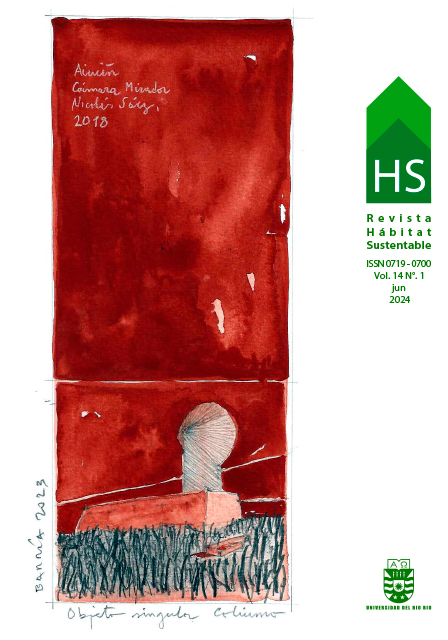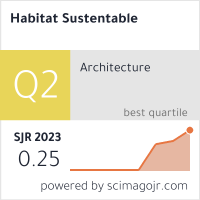Propuesta metodológica para medir el deslumbramiento en ambientes interiores mediante cuatro rangos de apertura ocular
DOI:
https://doi.org/10.22320/07190700.2024.14.01.01Palabras clave:
deslumbramiento, confort visual, indicadores ocularesResumen
El desarrollo de modelos de deslumbramiento contribuye a una mejor evaluación del confort visual de los ocupantes en espacios interiores. Los indicadores oculares pueden ser una herramienta adecuada para evaluar el deslumbramiento de manera dinámica en climas soleados para evitar las molestias visuales. En este trabajo, se mide el grado de apertura ocular y se propone su medición en cuatro rangos (oclusión, semi-oclusión, semi-apertura y apertura) por medio de un eye-tracker. El objetivo de este trabajo fue evaluar de qué manera se relaciona el grado de apertura ocular con los niveles de iluminancia vertical (Ev) inferiores a 2484 lx (valor donde aparece la sensación de deslumbramiento molesto), así como determinar si la percepción subjetiva del deslumbramiento de las personas corresponde a los rangos de deslumbramientos propuestos por Wienold (2019). Estos parámetros se midieron en tres condiciones de deslumbramiento percibido (notable, perturbador e intolerable). Los resultados mostraron que la medición de apertura ocular en cuatro rangos, tiene el potencial de cuantificar de manera objetiva y dinámica la sensación de deslumbramiento en todos los escenarios evaluados y en cuanto a su relación con los valores de Ev de referencia, los valores percibidos como notable y perturbador, fueron inferiores a los valores de referencia, mientras que los valores percibidos como intolerable fueron coincidentes.
Descargas
Citas
ABD-ALHAMID, F., KENT, M., y WU, Y. (2023). Quantifying window view quality: A review on view perception assessment and representation methods. Building and Environment, 227, 109742. https://www.sciencedirect.com/science/article/pii/S0360132322009726?via%3Dihub
ARIES, M. B. C., VEITCH, J. A., y NEWSHAM, G. R. (2010). Windows, view, and office characteristics predict physical and psychological discomfort. Journal of Environmental Psychology, 30(4), 533–541. https://doi.org/10.1016/j.jenvp.2009.12.004
BAZAREVSKY, V., KARTYNNIK, Y., VAKUNOV, A., RAVEENDRAN, K., y GRUNDMANN, M. (2019). Blazeface: Sub-millisecond neural face detection on mobile gpus. ArXiv Preprint ArXiv:1907.05047. https://arxiv.org/abs/1907.05047
BERMAN, S. M., BULLIMORE, M. A., JACOBS, R., BAILEY, I. L., y GANDHI, N. (1993). An Objective-Measure of Discomfort Glare. 1993 IESNA Annual Conference. https://www.tandfonline.com/doi/abs/10.1080/00994480.1994.10748079
BOYCE, P. R. (2003). Human factors in lighting. Crc Press.
CIE S 017/E:2020. (2020). ILV: International Lighting Vocabulary, 2nd Edition. https://cie.co.at/publications/ilv-international-lighting-vocabulary-2nd-edition-0
DILAURA, D. L. (2010). A New Lighting Handbook. LEUKOS 6(4), 256–258. Taylor & Francis. https://doi.org/10.1080/15502724.2010.10732125
DOUGHTY, M. J. (2014). Spontaneous eyeblink activity under different conditions of gaze (eye position) and visual glare. Graefe’s Archive for Clinical and Experimental Ophthalmology, 252, 1147–1153. https://doi.org/10.1007/s00417-014-2673-8
FOTIOS, S., y KENT, M. (2021). Measuring discomfort from glare: Recommendations for good practice. Leukos, 17(4), 338–358. https://eprints.whiterose.ac.uk/165602/3/fotios%20kent%202020%20measuring%20discomfort%20AUTHORS%20FINAL%20VERSION.pdf
HAMEDANI, Z., SOLGI, E., SKATES, H., HINE, T., FERNANDO, R., LYONS, J., y DUPRE, K. (2019). Visual discomfort and glare assessment in office environments: A review of light-induced physiological and perceptual responses. Building and Environment, 153, 267–280. https://doi.org/10.1016/j.buildenv.2019.02.035
HAMEDANI, Z., SOLGI, E., HINE, T., SKATES, H., ISOARDI, G., y FERNANDO, R. (2020a). Lighting for work: A study of the relationships among discomfort glare, physiological responses and visual performance. Building and Environment, 167, 106478. https://doi.org/10.1016/j.buildenv.2019.106478
HAMEDANI, Z., SOLGI, E., HINE, T., y SKATES, H. (2020b). Revealing the relationships between luminous environment characteristics and physiological, ocular and performance measures: An experimental study. Building and Environment, 172, 106702. https://doi.org/10.1016/j.buildenv.2020.106702
HOPKINSON, R. G. (1950). The multiple criterion technique of subjective appraisal. Quarterly Journal of Experimental Psychology, 2(3), 124–131. https://journals.sagepub.com/doi/10.1080/17470215008416585
HOPKINSON, R. G. (1957). Evaluation of glare. Illuminating Engineering, 52(6), 305–316. https://www.brikbase.org/sites/default/files/ies_038.pdf
JOHRA, H., GADE, R., POULSEN, M. Ø., CHRISTENSEN, A. D., KHANIE, M. S., MOESLUND, T., y JENSEN, R. L. (2021). Artificial Intelligence for Detecting Indoor Visual Discomfort from Facial Analysis of Building Occupants. Journal of Physics: Conference Series, 2042(1), 12008. https://iopscience.iop.org/article/10.1088/1742-6596/2042/1/012008
KOKOSCHKA, S., y HAUBNER, P. (1985). Luminance ratios at visual display workstations and visual performance. Lighting Research & Technology, 17(3), 138–144. https://doi.org/10.1177/14771535850170030101
LIN, Y., FOTIOS, S., WEI, M., LIU, Y., GUO, W., y SUN, Y. (2015). Eye movement and pupil size constriction under discomfort glare. Investigative Ophthalmology & Visual Science, 56(3), 1649–1656. https://doi.org/10.1167/iovs.14-15963
LUCKIESH, M., y GUTH, S. K. (1949). Brightness in the visual field at the borderline between comfort and discomfort (BCD). Illuminating Engineering, 44, 650–670. https://www.brikbase.org/sites/default/files/ies_035_0.pdf
MATHEW, V., KURIAN, C. P., VARGHESE, S. G., PRIYADARSHINI, K., y BHANDARY, S. S. (2023). Real-time investigations and simulation on the impact of lighting ambience on circadian stimulus. Arabian Journal for Science and Engineering, 48(5), 6703–6716. https://link.springer.com/article/10.1007/s13369-022-07510-0
OSTERHAUS, W. K. E. (1996). Discomfort glare from large area glare sources at computer workstations. In Proceedings for the 1996 International Daylight Workshop, Building with Daylight: Energy-Efficient Design., (pp. 103–110). https://www.researchgate.net/publication/323350484_Review_of_Factors_Influencing_Discomfort_Glare_Perception_from_Daylight
OSTERHAUS, W. K E, y BAILEY, I. L. (1992). Large area glare sources and their effect on visual discomfort and visual performance at computer workstations. Conference Record of the 1992 IEEE Industry Applications Society Annual Meeting, 1825–1829. https://www.osti.gov/servlets/purl/10125235.
PERERA, A. (2023). Hawthorne effect: Definition, how it works, and how to avoid it. Simply Psychology. https://www.simplypsychology.org/hawthorne-effect.html
PIERSON, C., WIENOLD, J., y BODART, M. (2017). Discomfort glare perception in daylighting: influencing factors. Energy Procedia, 122, 331–336. https://doi.org/10.1016/j.egypro.2017.07.332
QUEK, G., JAIN, S., KARMANN, C., PIERSON, C., WIENOLD, J., y ANDERSEN, M. (2023). Comparison of questionnaire items for discomfort glare studies in daylit spaces. Lighting Research & Technology, 14771535231203564. http://dx.doi.org/10.1177/14771535231203564
QUEK, G., WIENOLD, J., KHANIE, M. S., ERELL, E., KAFTAN, E., TZEMPELIKOS, A., KONSTANTZOS, I., CHRISTOFFERSEN, J., KUHN, T., y ANDERSEN, M. (2021). Comparing performance of discomfort glare metrics in high and low adaptation levels. Building and Environment, 206, 108335. https://doi.org/10.1016/j.buildenv.2021.108335
RODRIGUEZ, R. G., GARRETÓN, J. A. Y., y PATTINI, A. E. (2017). An epidemiological approach to daylight discomfort glare. Building and Environment, 113, 39–48. http://dx.doi.org/10.1016/j.buildenv.2016.09.028
SAREY KHANIE, M. (2015). Human Responsive Daylighting in Offices: a Gaze-driven Approach for Dynamic Discomfort Glare Assessment. Ecole polytechnique federale de Lausanne. http://thedaylightsite.com/human-responsive-daylighting-in-offices/
SAREY KHANIE, M., STOLL, J., MENDE, S., WIENOLD, J., EINHÄUSER, W., y ANDERSEN, M. (2013). Uncovering relationships between view direction patterns and glare perception in a daylit workspace. https://www.researchgate.net/publication/280728553_Uncovering_relationships_between_view_direction_patterns_and_glare_perception_in_a_daylit_workspace
SHARAM, L. A., MAYER, K. M., y BAUMANN, O. (2023). Design by nature: The influence of windows on cognitive performance and affect. Journal of Environmental Psychology, 85, 101923. https://doi.org/10.1016/j.jenvp.2022.101923
SHIN, J. Y., YUN, G. Y., y KIM, J. T. (2012). Evaluation of daylighting effectiveness and energy saving potentials of light-pipe systems in buildings. Indoor and Built Environment, 21(1), 129–136. https://doi.org/10.1177/1420326X11420011
SUK, J. Y., SCHILER, M., y KENSEK, K. (2016). Absolute glare factor and relative glare factor based metric: Predicting and quantifying levels of daylight glare in office space. Energy and Buildings, 130, 8–19. https://thuvien.huce.edu.vn/kiposdata1/baotapchi/Tapchinuocngoai/Energy%20and%20Buildings/Energy%20and%20Buildings.Vol%20130.A3.pdf
TSAO, L.-J. (2008). Driver drowsiness detection and warning under various illumination conditions.Master Tesis. Institute of Computer Science and Information Engineering National Central University Chungli.
WIENOLD, J., y CHRISTOFFERSEN, J. (2006). Evaluation methods and development of a new glare prediction model for daylight environments with the use of CCD cameras. Energy and Buildings, 38(7), 743–757. https://www.sciencedirect.com/science/article/abs/pii/S0378778806000715
WIENOLD, J., IWATA, T., SAREY KHANIE, M., ERELL, E., KAFTAN, E., RODRIGUEZ, R. G., YAMIN GARRETÓN, J. A., TZEMPELIKOS, T., KONSTANTZOS, I., CHRISTOFFERSEN, J., y others. (2019). Cross-validation and robustness of daylight glare metrics. Lighting Research & Technology, 51(7), 983–1013. https://journals.sagepub.com/doi/full/10.1177/1477153519826003
YAMIN GARRETÓN, J. A., RODRIGUEZ, R. G., y PATTINI, A. E. (2016). Glare indicators: an analysis of ocular behaviour in an office equipped with venetian blinds. Indoor and Built Environment, 25(1), 69–80. https://doi.org/10.1177/1420326X14538082
YAMIN GARRETÓN, J., RODRIGUEZ, R. G., RUIZ, A., y PATTINI, A. E. (2015). Degree of eye opening: A new discomfort glare indicator. Building and Environment, 88, 142–150. https://www.sciencedirect.com/science/article/abs/pii/S0360132314003631
YAN, G., y GRISHCHENKO, I. (2022). MediaPipeFace Landmark. https://www.researchgate.net/publication/364279614_MediaPipe's_Landmarks_with_RNN_for_Dynamic_Sign_Language_Recognition
Descargas
Publicado
Cómo citar
Número
Sección
Licencia
Derechos de autor 2024 Julieta Yamin-Garretón, Darío Jaime, Maureen de Gastines, Emanuel Schumacher, Andrea Pattini

Esta obra está bajo una licencia internacional Creative Commons Atribución-CompartirIgual 4.0.
El contenido de los artículos que se publican en cada número de Hábitat Sustentable, es responsabilidad exclusiva de los autores y no representan necesariamente el pensamiento ni comprometen la opinión de la Universidad del Bío-Bío.
Los autores/as conservarán sus derechos de autor y garantizarán a la revista el derecho de primera publicación de su obra, el cuál estará simultáneamente sujeto a la Licencia de Reconocimiento de Creative Commons CC BY-SA que permite a otros compartir-copiar, transformar o crear nuevo material a partir de esta obra con fines no comerciales, siempre y cuando se reconozcan la autoría y la primera publicación en esta revista, y sus nuevas creaciones estén bajo una licencia con los mismos términos.











 Programa de Información Científica/Concurso Fondos de Publicación de Revistas Científicas 2018/ Proyecto Mejoramiento de Visibilidad de Revistas UBB (Código:FP180007)
Programa de Información Científica/Concurso Fondos de Publicación de Revistas Científicas 2018/ Proyecto Mejoramiento de Visibilidad de Revistas UBB (Código:FP180007) 





